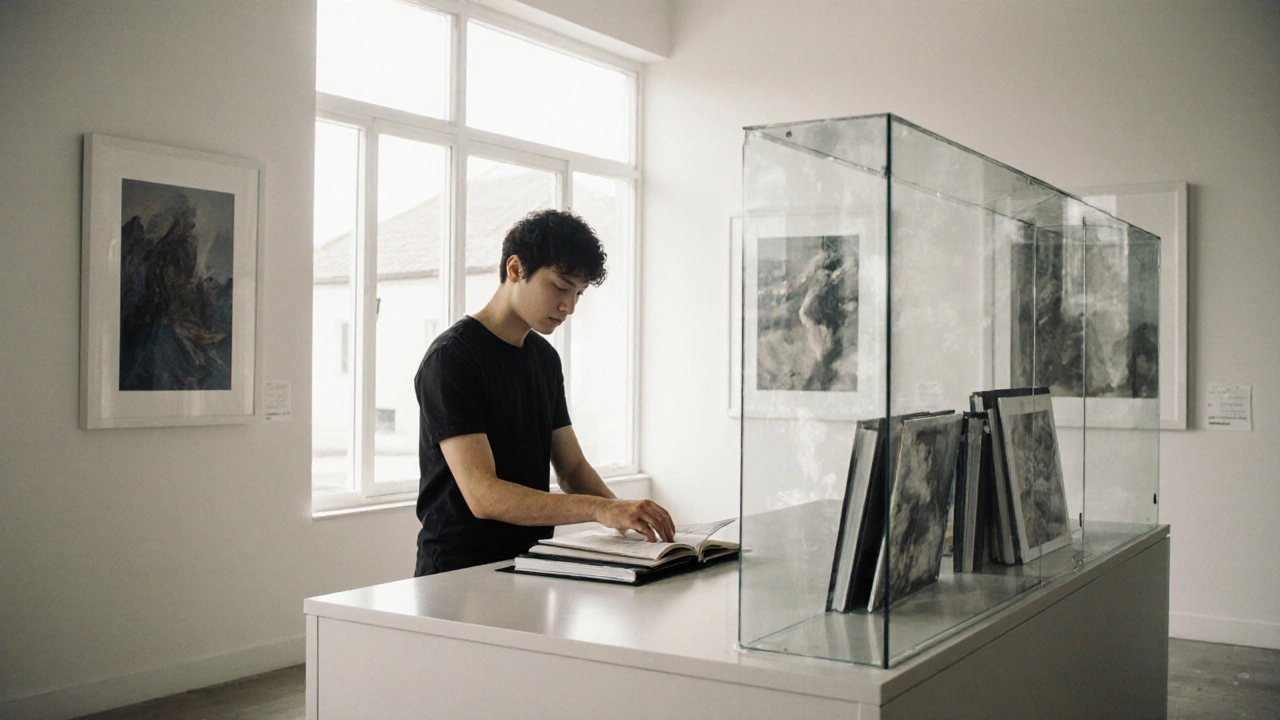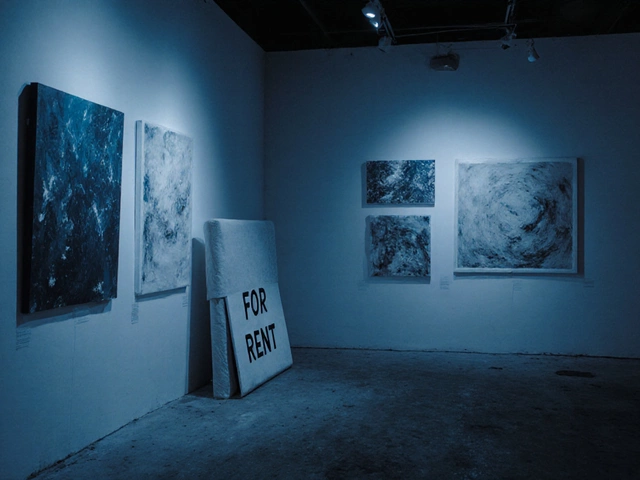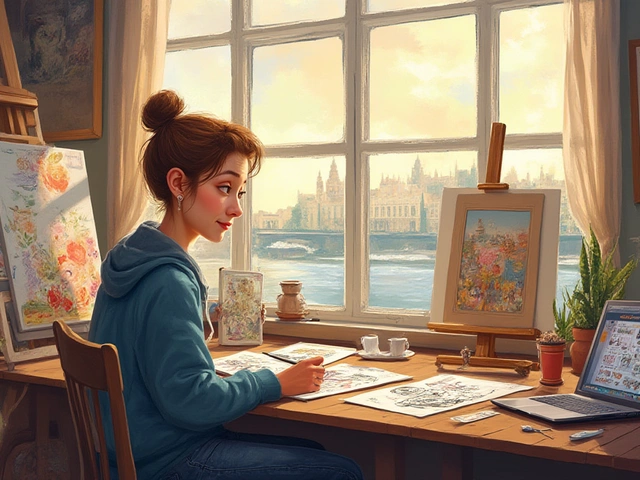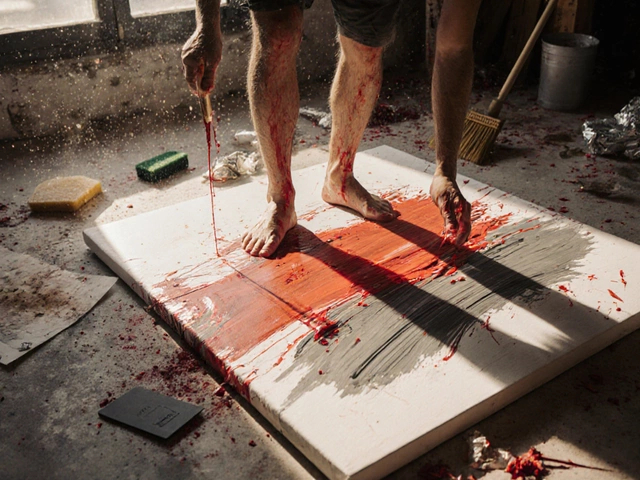Getting into a gallery isn’t about luck. It’s not about having a viral Instagram post or knowing someone who knows someone. It’s about showing up consistently, understanding how galleries work, and proving you’re worth their time. Most artists spend years trying to break in-some never do. But those who do? They didn’t wait for permission. They built a track record.
What Galleries Actually Look For
Galleries aren’t charity organizations. They’re businesses. They need to sell work to stay open. That means they’re looking for artists who can deliver consistent, high-quality pieces that fit a clear aesthetic, have a growing audience, and can be marketed without constant hand-holding.
They don’t want someone who makes one-off pieces. They want someone who can produce a body of work-say, 10 to 15 pieces-that feels like a cohesive exhibition. They want to see that you’ve developed a visual language, not just random sketches.
Take, for example, a Wellington-based painter who started showing at a small downtown gallery in 2023. She didn’t send cold emails. She spent two years attending every opening, talking to gallery owners, and leaving her portfolio on their desk during open submission weeks. She didn’t ask for a show. She asked questions: “What kind of artists do you typically represent?” “What’s the biggest challenge you’ve had with new artists?” She listened. She adapted. She showed up.
Submission Rules Are Real-And They Matter
Every gallery has submission guidelines. Read them. Follow them. Ignore them at your own risk.
Some galleries only accept submissions via online portals. Others require printed portfolios mailed in a specific size. A few still only meet artists in person during open studio nights. If you send a PDF when they asked for a physical portfolio, your work won’t even be seen. It’s that simple.
One gallery in Auckland told me they get over 200 submissions a month. Less than 1% make it to the review stage. Why? Because 80% of applicants don’t follow the instructions. They send videos when they’re asked for images. They include resumes that list their day job as a barista and call it an “art career.” They don’t label files properly. They don’t include prices.
Here’s what you need to include:
- 10-15 high-resolution images of your best work (JPG or PNG, under 5MB each)
- A short artist statement (under 200 words) that explains your intent, not your technique
- A CV that lists exhibitions, residencies, awards, and relevant education-not your high school art class
- Clear pricing for each piece (even if you’re open to negotiation)
- Your contact info-email and website, not just Instagram
And never, ever send unsolicited work in the mail. It gets thrown out. No one has space for it.
Start Small-Then Build Up
Most artists dream of showing at the Tate or MoMA. But those places don’t take unknown artists. They work with established names or those who’ve already proven themselves in smaller spaces.
The real path? Start local. Find a cooperative gallery, a pop-up space, or a community center that hosts rotating shows. These places take new artists. They don’t pay much-sometimes nothing-but they give you exposure, credibility, and experience.
One artist I know in Christchurch spent 18 months showing in coffee shops, libraries, and unused retail spaces. Each time, she documented the show, tagged the venue, and sent the photos to galleries she admired. After her third pop-up, a gallery owner reached out: “You’ve got a following. You show up. You’re professional. Let’s talk.”
Don’t wait for the perfect moment. Create your own. A group show at a bookstore counts. A solo display in a dentist’s waiting room counts. It’s not about the venue-it’s about building a history of exhibitions.

Relationships Are Everything
You don’t need to be friends with a gallery owner. But you do need to be someone they trust.
Go to openings. Say hello. Ask thoughtful questions. Don’t pitch your work. Don’t hand them your card. Just be present. Over time, they’ll notice you. Not because you’re loud, but because you’re consistent.
One artist in Dunedin started showing up at every gallery opening in the city for two years. She didn’t ask for anything. She just showed up. She remembered names. She asked about other artists’ work. After 14 months, the owner of a small gallery asked her if she’d like to be in their next group show. She said yes. She sold three pieces. The next year, she had a solo show.
Galleries don’t hire artists. They choose people they believe will stick around. They want someone who’ll show up for the installation, answer emails promptly, and treat the space with respect.
Online Presence Isn’t Optional
Yes, you need a website. Not an Instagram profile. Not a Behance portfolio. A real website with your name as the domain.
It doesn’t need to be fancy. Just clean. Easy to navigate. Includes:
- Your best 10-15 images
- A short bio
- Exhibition history
- Contact info
- Price list (or a note that prices are available on request)
Why? Because every gallery will check it. If your website looks like a 2012 Geocities page, they’ll assume you’re not serious. If you don’t have one, they’ll assume you’re not professional.
Use Squarespace, Wix, or even WordPress. Pay for the domain. Use your real name. Make sure the site loads fast on mobile. That’s it. You don’t need animations or videos. You need clarity.
Timing Is Everything
Galleries plan shows 6 to 12 months in advance. If you submit in January, you might get a response in May-but your show won’t be until next winter.
Don’t submit right before Christmas or during summer holidays. Most galleries close for a few weeks. Your email will sit in a folder and get lost.
The best time to submit? Late February to early April, or September to October. That’s when curators are planning their next year’s calendar. They’re looking for new voices. They’re ready to review.

What Happens After You Get In?
Getting into a gallery is just the beginning. Now you have responsibilities.
You’ll need to deliver your work on time. You’ll need to be available for installation. You’ll need to show up for the opening-even if you’re nervous. You’ll need to talk to buyers, even if you hate it.
Galleries take 40-50% commission. That’s standard. They cover the space, the lighting, the marketing, the staff. In return, they give you credibility and access to buyers you’d never reach on your own.
But here’s the catch: if you don’t sell anything, they won’t take you again. Not because they’re mean. Because they have to pay rent. They need to make money to keep the lights on.
So don’t treat a gallery show as a trophy. Treat it like a job. Show up. Do the work. Follow through.
What Doesn’t Work
Here are the myths that keep artists stuck:
- “I just need one big break.” There’s no such thing. It’s a slow build.
- “My art is too good to be ignored.” It’s not. Thousands of artists think that. Talent isn’t enough.
- “I’ll get noticed on Instagram.” Maybe. But galleries don’t hire based on likes. They hire based on consistency, professionalism, and sales potential.
- “I’ll wait until I’m ready.” You’ll never feel ready. Start now.
The artists who make it aren’t the most talented. They’re the ones who kept going when no one was watching. Who showed up. Who followed rules. Who treated every small opportunity like it mattered.
Final Thought: It’s a Marathon, Not a Sprint
There’s no secret formula. No magic email template. No insider trick.
There’s only this: do the work. Learn the system. Show up. Repeat.
One artist from Tauranga submitted to 47 galleries over three years. Got rejected 42 times. Got into five. Three of those were one-off shows. Two became long-term relationships. One of those two now represents her internationally.
She didn’t have a famous mentor. She didn’t go to art school. She just didn’t quit.
Do I need an art degree to get into a gallery?
No. While many gallery-represented artists have degrees, many don’t. Galleries care more about the quality and consistency of your work, your exhibition history, and how professional you are in communication and delivery. A degree can help open doors, but it’s not a requirement.
How long does it usually take to get into a gallery?
It varies. Some artists get in within a year if they’re proactive and have a strong body of work. Others take three to five years. The average is about two to three years of consistent effort-submitting, showing in smaller spaces, building a website, and attending events.
Should I pay to be in a gallery?
Never pay a gallery to exhibit your work. Legitimate galleries make money by selling your art, not by charging you fees. If a gallery asks for an “exhibition fee,” “membership fee,” or “marketing fee,” walk away. That’s a vanity gallery, not a real one.
Can I approach galleries if I only make digital art?
Yes. Digital art is increasingly accepted, especially if it’s printed on high-quality materials like canvas, metal, or archival paper. Some galleries specialize in digital or new media. Others will take it if it fits their aesthetic. Make sure your prints are produced professionally and priced appropriately.
What if I live in a small town with no galleries?
Start by building your online presence and showing work in nearby cities. Many regional galleries accept submissions from artists outside their area. You can also collaborate with local businesses-libraries, cafes, bookstores-to host pop-up shows. Document these shows and use them as proof of experience when applying to larger galleries.
How many pieces should I have ready before applying?
Aim for at least 10-15 finished, cohesive pieces. This shows you can produce a body of work, not just one-off ideas. Galleries want to know you can fill a space with a consistent vision. If you’re applying for a solo show, you’ll need 15-20 pieces. For group shows, 3-5 strong works are usually enough.





